Download the article in pdf format
Publication date: 01.06.2021
DOI: 10.51871/2588-0500_2021_05_02_26
UDC 796.034:004.942
The research was carried out with the support of the Russian Foundation for Basic Research within the scientific project № 19-313-90042 from 23.08.2019.
ANALYSIS OF COMPETITIVE ACTIVITIES OF BASKETBALL TEAMS OF DIFFERENT QUALIFICATION USING INTEGRAL INDICATORS
D.V. Fedoseev1, V.V. Kozin2
1FSAEI of HE “Southern Federal University”, Rostov-on-Don, Russia
2FSAEI of HE “Omsk State Agrarian University”, Omsk, Russia
Key words: statistics, technique, tactics, basketball.
Annotation. The purpose of this study was to reveal the composition of individual and team competitive activities of basketball players of different qualification using specific integral indicators. Among indicators, the following were revealed: a way to begin a team possession of the ball; numbers of players, who participated in the current possession; time, taken for the possession; a way to end the team possession; zone, from which the attack was delivered; amount of points gained with a successful attack. In order to make additions to integral indicators, a formula, which reveals the effectiveness coefficient, was used. As a result, ways to begin the team possession of the ball, as well as positive and negative aspects of the technical and tactical activities of basketball players of different qualification, were identified.
Introduction. In modern sports games, high requirements for the mastery and level of preparedness of athletes determine and actualize the role of managing and optimizing the competitive process in long-term training.
Analysis of specialized literature revealed an insufficient amount of studies, aimed at using modern technologies of analysis of competitive activity of basketball players [3, 8]. At the same time, in order to increase competitive advantage on the international arena, it is important to take organization of the training process of qualified basketball players to a completely new level, taking modern requirements of competitive activities into account [5, 7].
Lately, intellectual analysis of a large data set becomes more and more popular in sports. Using modern computer technologies, artificial intelligence allows improving the training process [2, 6]. Because of correct consistent process of obtaining and interpreting data, coaches have a possibility to evaluate the effectiveness of athletes, usage of tried-and-tested and variable-based strategies, as well as tactical and technical models of their own team and the opponent’s team.
Using of modern technologies to analyze in-game activity gives a significant advantage over the opponent. The significance of integral criteria [4], which allow evaluating promptly the competitive proves to an accomplished standards and make corrections in athletes’ training, takes the first role in this direction.
The purpose of this study is to reveal the composition of individual and team competitive activities of basketball players of different qualification using specific integral indicators.
Methods and organization. The study was carried out on a basketball team, participating in the Championship of Russia among women teams of the Russian Basketball Super League 1 (SL-1) and in the European Women’s Basketball League (EWBL). Elite athletes aged of 17-22 years were chosen for the selection. 83 games and 7747 cases of ball possessions were registered and analyzed.
Following indicators, which were integral in relation to a big amount of statistical data, used during basketball games, were registered: a way to begin a team possession of the ball; numbers of players, who participated in the possession; time taken for the possession; a way to end the team possession; zone, from which the attack was delivered; amount of points gained with a successful attack. Other in-game indicators were taken from the final protocol.
In order to determine the percentage of hits, the data acquisition method was applied using the ball throws map with 14 zones, in which a number of throws and hits was registered (Fig. 1).
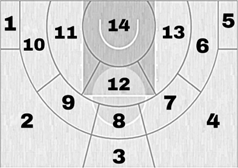
Fig. 1. Ball throws map
The evaluating formula for individual and team actions of players was used to make additions to integral indicators:
Effectiveness ratio = (Points + Rebounds + Assists + Tackling + Blocks + real. (Total amount of throws) + Real. (Free throws) - Hits (Total amount of throws) -Turnovers)/200
where 200 – is a total playing time of players entering the court, provided that that all games end in regular time. The indicators evaluation was carried out according to parameters presented in the table 1.
Table 1
Evaluation of integral indicators of competitive activity
|
Indicator |
Low level |
Average level |
High level |
|
Attacks’ effectiveness |
Less than 0,70 |
0,70 to 0,85 |
0,85 and higher |
|
Effectiveness ratio (combination of individual and team tactical and technical activity ) |
Less than 0,30 |
0,30 to 0,45 |
0,45 and higher |
Results and discussion. As a result of the analysis of basketball players’ competitive activities, the offensive phase was divided into 4 segments.
The first segment (0-4 s, 1-2 ball touches, 48,6% and 36,4% respectively) is characterized as the fast break, according to classic terminology. The ball possession could be ended within this timespan due to active movements of the opponent in the backcourt (press defense). Choosing of such timespan aligns with standard requirements for the 20-meter break (not more than 3,6 s).
Zones, from which ball throws to the rim are made, are considered as the typical feature for this segment. As it was shown in Fig. 2, 80,9% of all attacks complete at close range, which is shown by high effectiveness (0,84 points) from the possession attempts in this timespan (Table 2).
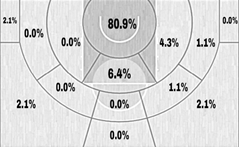
Fig. 2. Ball throws distribution to zones within the first time segment
Table 2
Effectiveness of the ball possession in the first segment
|
Time, s |
Amount of ball possessions |
Segment sum |
Amount of points |
Segment sum |
Effectiveness on every second |
Effectiveness |
|
0 |
0,1 |
7,6 |
0,1 |
6,4 |
1,00 |
0,84 |
|
1 |
1,1 |
0,4 |
0,38 |
|||
|
2 |
1,5 |
1,3 |
0,89 |
|||
|
3 |
2,0 |
1,8 |
0,90 |
As a rule, the second segment (5-9 s, 2-3 ball touches, 35,3% and 34,7% respectively) corresponds with the early offense stage, when the offence team does not have numerical advantage in the frontcourt, but their attack has high dynamics, and it is difficult for the opponent to organize defense. This segment is also characterized by a majority of attacks at close range (Fig. 3), however, in comparison with the first segment, there is an obvious difference, which is 31,3%. A number of attacks at close middle range and 3-point field goals increases significantly.
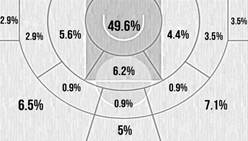
Fig. 3. Ball throws distribution to zones within the second time segment
The results obtained are explained by the fact that the defense manages to limit the access to the 3-second zone by that time. However, the total high effectiveness of the second segment, which is 0,80 (Table 3), indicates that possibilities for successful attacks are high, but, in comparison with the first segment, there is a decrease in the attacks’ effectiveness.
Table 3
Effectiveness of the ball possession in the second segment
|
Time, s |
Amount of ball possessions |
Segment sum |
Amount of points |
Segment sum |
Effectiveness on every second |
Effectiveness |
|
5 |
3,2 |
19,5 |
3,2 |
15,5 |
1,00 |
0,80 |
|
6 |
4,3 |
4,3 |
1,00 |
|||
|
7 |
3,3 |
1,9 |
0,58 |
|||
|
8 |
3,9 |
2,9 |
0,74 |
|||
|
9 |
4,8 |
3,4 |
0,71 |
The third segment (10-19 s, 3-6 ball touches, 80% of all attacks). A choice of the initial second was made because of not only the amount of touches, but also the specificity of rules: for second chance attacks and in case of earning a foul by the defender, the 24-second timer is set on the 14th second of the ball possession.
As a rule, this timespan includes halfcourt offence, characterized by a great amount of passes, tactical interactions (picks with and without a ball). At this stage of offense, the opponent’s team manages to form organized defense, and participation of greater amount of offense players is needed to overcome it.
The fact of further decrease in the attack percentage from close range down to 41,2% is logical (Fig. 4). Since it is easier to earn points within this timespan, the opponent trying their best to limit the access to the 3-second zone, using various organized forms of defense at this stage.
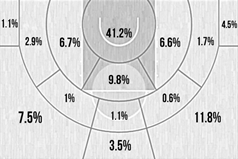
Fig. 4. Ball throws distribution to zones within the third time segment
The study revealed that 4,9 ball touches in average or 3,9 passes are needed to counteract zone forms of defense, 3,5 ball touches and 2,5 passes – to counteract man-to-man defense. Therefore, an increase in the percentage of attacks from long distance up to 28,4% is understandable.
It is important to note the decreasing effectiveness of possessions from segment to segment (Table 4) in case of an increase of total amount of attacks in the given timespan.
Table 4
Effectiveness of the ball possession in the third segment
|
Time, s |
Amount of ball possessions |
Segment sum |
Amount of points |
Segment sum |
Effectiveness on every second |
Effectiveness |
|
10 |
5,6 |
42,6 |
4,9 |
33,6 |
0,87 |
0,79 |
|
11 |
4,9 |
2,8 |
0,58 |
|||
|
12 |
5,3 |
4,3 |
0,83 |
|||
|
13 |
5,1 |
4,0 |
0,79 |
|||
|
14 |
5,5 |
4,5 |
0,82 |
|||
|
15 |
4,1 |
3,5 |
0,86 |
|||
|
16 |
3,4 |
2,5 |
0,73 |
|||
|
17 |
3,7 |
2,7 |
0,73 |
|||
|
18 |
2,5 |
2,1 |
0,84 |
|||
|
19 |
2,6 |
2,1 |
0,81 |
The fourth segment (20-24 s, 5-9 ball touches, 80% of all attacks) is a final phase of halfcourt offense. This segment should be separately highlighted, because it is characterized by a great number of ball touches (Fig. 5). Moreover, it is a psychologically complicated segment due to the fact that time given for the attack is running out, and the offense team, being under pressure, shows low effectiveness [1]. Significant differences from the previous segment, according to distribution of attacks on the ball throws map, were not registered.
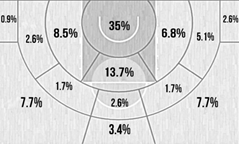
Fig. 5. Ball throws distribution to zones within the third time segment
The significant decrease of the attack effectiveness in this segment, in comparison with the previous three, confirms a theory about complexity of conditions for the offense team (Table 5). In most cases, the inability to attack in earlier offense phases indicates the prevalence of defense in the current ball possession. In case when the number of “long” attacks is getting bigger, the opponent team gains greater advantage. Tactical suggestions, made by a coach, are an exception; however, it is important to observe promptly the effectiveness of attacks during the game.
Table 5
Effectiveness of the ball possession in the fourth segment
|
Time, s |
Amount of ball possessions |
Segment sum |
Amount of points |
Segment sum |
Effectiveness on every second |
Effectiveness |
|
20 |
2,0 |
6,3 |
1,4 |
3,5 |
0,67 |
0,57 |
|
21 |
1,3 |
0,7 |
0,55 |
|||
|
22 |
1,0 |
0,7 |
0,70 |
|||
|
23 |
1,4 |
0,5 |
0,38 |
|||
|
24 |
0,5 |
0,2 |
0,34 |
Along with the significance of features of the ball possession’s completion, it is important to understand how these possessions began, because in-game conditions create different possibilities for offense phases’ implementation. The results obtained allowed identifying five ways to begin the ball possession.
The first way, which is implemented after rebound in defense, accounted for 28% of all attacks. In case of this type, favorable conditions are created for developing attacks within first two timespans. When rebounding in defense, 46% of all attacks are completed before the 9th second of 24 possible ones. Moreover, completions of these possessions are characterized by low and average level of the effectiveness, which indicates an insufficient formedness of this component in the team, when there are theoretically good possibilities to deliver effective attacks.
The second way, which is implemented after another ball possession with missed points (passing the ball from the end line) is as frequent as the previous one, and accounts 30% of the total amount of ball possessions. With the given condition, there is a possibility to execute attacks in first segments. Time does not stop, the ball is “live”, and offense team members do not have limits for quick ball inbound, excluding opponent’s counteractions. Time, taken for going over the end line for inbound, is used by the defense team to set their defense. That is why in case of this scenario, the percentage of attacks is significantly decreased down to 19% within first two segments.
The fifth part of all attacks accounts for the third way – ball possessions, which begin with the “dead” ball inbound. In practice, it is considered as a stationery situation. It is quite understandable that 80% of all attacks’ completions were accounted for the third and fourth segments. It is quite logical that attacks in this case require more precise training and, respectively, more time and involvement of players into the halfcourt offense organizing.
The most effective attacks, beginning with passing the ball from one team to another, are accounted for the fourth way – possessions, beginning with ball tackling. The effectiveness of such attacks is on the level of 0,82 points (16%), which is indeed lower than expected due to the fact that this way of the ball possession gives a great advantage to the offense team, because defense is unable to counteract. As a rule, this situation is characterized not by the tactical attack organization, but also the mastery of implementation of numerical advantage or situation of unequal distribution of players.
The fifth way is the second chance attack. This is the only way to begin the ball possession without losing the ball by the opponent. Players do not need to go from the backcourt into the frontcourt and, consequently, there is no need to divide these possessions into segments. This type of attack has the highest effectiveness – 1,21 points gained from the possession.
Conclusion. The conducted study allowed conducting quantitative and qualitative evaluation of specific in-game indicators based on the integral criterion. Segmented phases of offence based on timespans, each of which has a clearly profound characteristics for such parameters as the amount of touches, preferred offense zones and the possession effectiveness, allowed identifying disadvantages in organizing the offense structure.
Limiting indicators include: a total amount of possessions; extremely high inclination to distribute attacks to 3 and 4 segments; high percentage of loses in all segments except the third one; low effectiveness of the first and fourth segments; insufficient amount of attacks in the first segment when possessing the ball after lost points; a quite mediocre indicator of team’s effectiveness. Exclusion of limiting indicators allow achieving high percentage of outside shots, increase an amount of rebounds and increase the effectiveness of attacks after them.
References
- Al Taj Kh. The direction of the playing style depending on the typological features of elite basketball players / Kh. Al Taj // Physical Culture and Health of Students of Higher Education Establishments: Materials from the VIII All-Russian Scientific and Practical Conference. January 27, 2012. – Saint Petersburg. – 2012. – P. 165-166.
- Kolumbet A.N. Qualimetric evaluation of technical and tactical actions of basketball players/ A.N. Kolumbet, D.S. El'tsov, N.Yu. Maksimovich // Issues and Prospects of the Development of Sports Games and Martial Arts in Higher Education Establishments: II International Electronic Scientific Conference (February 7, 2006) / Kharkiv State Academy of Physical Culture [et al]. – Kharkiv; Belgorod; Krasnoyarsk. – 2006. – P. 111-114.
- Kozin V.V. Comprehensive testing of preparedness of young basketball players to overcome counteractions of defenders / V.V. Kozin // Omsk Scientific Bulletin. – 2012. – Issue. 1 (105). – P. 177-180.
- Kozin V.V. Modern information technologies of registering and analysis of competitive activity in sports games / V.V. Kozin // Issues and Prospects of the Development of Physical Culture and Sports: Materials of the XIII All-Russian Scientific and Practical Conference in March 25-26 in Kemerovo. – Omsk: Publishing House of the SibSUPC. – 2015. – P. 169-172.
- Losin B.E. Features of competitive activity of basketball players in extreme game situations / B.E. Losin, V.V. Zhuk // Methodology and Organization of Learning and Training Process in Physical Culture and Sports: Materials of the International Scientific and Methodological Conference of the Belgor. State University in November 19-21, 2002. – Belgorod. – 2002. – S. 158-159.
- Jianyun C.A. Unified framework for semantic content analysis in sports video / C.A. Jianyun // Proc. 2nd Int. Conf. Information Technology for Application (ICITA). – 2004. – P. 149-153.
- Lehto, H. Technical and tactical game analysis of elite basketball in three different levels / H. Lehto // KIHU’s publication series. – 2010. – № 19. – 33 p.
- Pers, J. Analysis and visualization of results, obtained by tracking players in team sports / J. Pers, S. Kovacic // Proceedings of the Ninth Electrotechnical and Computer Science Conference, ERK–2000. – Portoroz, Slovenija, September. – 2000. – P. 261-264.
Spisok literatury
- Al Taj Kh. Napravlennost' igrovogo stilya v zavisimosti ot tipologicheskikh osobennostej kvalifitsirovannykh basketbolistov / Kh. Al Taj // Fizicheskaya kul'tura i zdorov'e studentov vuzov: materialy VIII Vserossijskoj nauchno-prakticheskoj konferentsii. 27 yanvarya 2012 g. – SPb. – 2012. – S. 165-166.
- Kolumbet A.N. Kvalimetricheskaya otsenka tekhniko-takticheskikh dejstvij basketbolistov / A.N. Kolumbet, D.S. El'tsov, N.Yu. Maksimovich // Problemy i perspektivy razvitiya sportivnykh igr i edinoborstv v vysshikh uchebnykh zavedeniyakh: II mezhdunar. elektron. nauch. konf. (7 fevr. 2006 g.) / Khar'kovskaya gos. akad. fiz. kul'tury [i dr.]. – Khar'kov; Belgorod; Krasnoyarsk. –2006. – S. 111-114.
- Kozin V.V. Kompleksnoe testirovanie podgotovlennosti yunykh basketbolistov k preodoleniyu protivodejstvij zashchitnikov / V.V. Kozin // Omskij nauchnyj vestnik. – 2012. – Vyp. 1 (105). – S. 177-180.
- Kozin V.V. Sovremennye informatsionnye tekhnologii registratsii i analiza sorevnovatel'noj deyatel'nosti v sportivnykh igrakh / V.V. Kozin // Problemy i perspektivy razvitiya fizicheskoj kul'tury i sporta : materialy XIII Vseros. nauchno-prakticheskoj konferentsii 25-26 marta g. Kemerovo. – Omsk : Izd-vo SibGUFK. – 2015. – S. 169-172.
- Losin B.E. Osobennosti sorevnovatel'noj deyatel'nosti basketbolistov v ekstremal'nykh igrovykh situatsiyakh / B.E. Losin, V.V. Zhuk // Metodologiya i organizatsiya uchebnogo i trenirovochnogo protsessa v fizicheskoj kul'ture i sporte: Materialy Mezhdunar.nauch.-metod. konf. Belgor. gos.un-ta 19-21 noyab. 2002g. – Belgorod. – 2002. – S. 158-159.
- Jianyun C.A. Unified framework for semantic content analysis in sports video / C.A. Jianyun // Proc. 2nd Int. Conf. Information Technology for Application (ICITA). – 2004. – P. 149-153.
- Lehto, H. Technical and tactical game analysis of elite basketball in three different levels / H. Lehto // KIHU’s publication series. – 2010. – № 19. – 33 p.
- Pers, J. Analysis and visualization of results, obtained by tracking players in team sports / J. Pers, S. Kovacic // Proceedings of the Ninth Electrotechnical and Computer Science Conference, ERK–2000. – Portoroz, Slovenija, September. – 2000. – P. 261-264.
Information about the authors: Dmitrij Vladimirovich Fedoseev – coach-instructor of the Center of Sports Training in the FSAEI of HE “Southern Federal University”, Rostov-on-Don; Vadim Vital’evich Kozin – Candidate of Pedagogical Sciences, Associate Professor of the Department of Physical Culture and Sports of the FSAEI of HE “Omsk State Agrarian University”, Omsk, e-mail: This email address is being protected from spambots. You need JavaScript enabled to view it..


